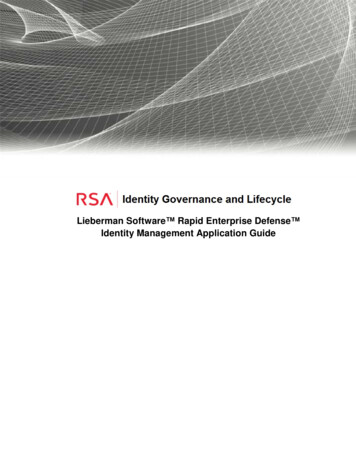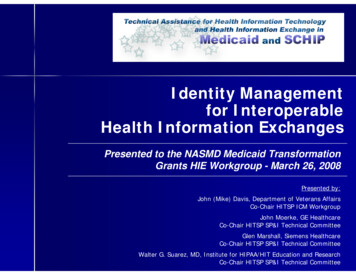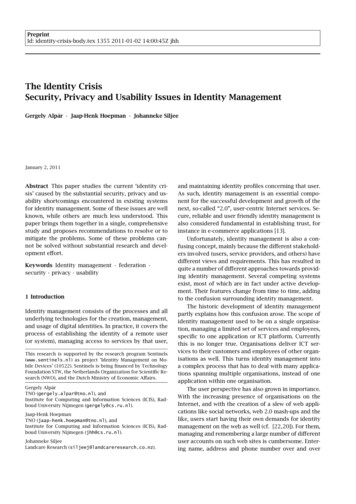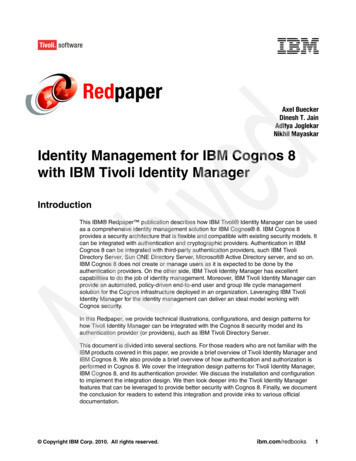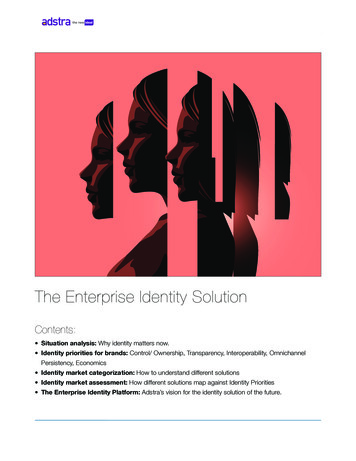
Transcription
The Enterprise Identity SolutionContents: Situation analysis: Why identity matters now. Identity priorities for brands: Control/ Ownership, Transparency, Interoperability, OmnichannelPersistency, Economics Identity market categorization: How to understand different solutions Identity market assessment: How different solutions map against Identity Priorities The Enterprise Identity Platform: Adstra’s vision for the identity solution of the future.
2 of 8SITUATION ANALYSIS:The ability to effectively recognize and target a customer is becoming harder every day in spite of the continuingimprovement of data and technology. New government regulations, shifting consumer expectations, and thespecter of big tech control have all made things more complex and more dif cult. These political and behavioraltrends have offset raw technological innovation in such a permanent way that marketers must now nd newapproaches in how they manage customer identity and data to remain successful over time.Marketers cannot afford to make do with a range of quick and easy alternatives. The resurgence of contextualdata, probabilistic cohorts, and media mix modeling represent steps backwards from the current state oftechnology. They threaten dilution in value and data loss, they are less precise and accountable, but mostimportantly, these methods threaten to further separate the brand from its customer. With the continueddiversi cation of media, from streaming TV, podcasts, gaming, and newer virtual reality environments, thechallenge of a consistent customer relationship is becoming more complex every day. Brands must nd a way toharness the power of identity in a manner that preserves privacy, transparency and control.With this in mind, this paper sets out to help brands better understand the overall identity market, to betterunderstand how identity impacts their business, and how they can build a long-term solution for identitymanagement from among the solutions currently in the market. In Adstra’s view, brands are in a better place toestablish a long-term vision and investment strategy around what we call an Enterprise Identity Solution. A solutionfifififithat will ensure the continued success of a brand’s marketing and customer journey efforts.
3 of 8LONG-TERM IDENTITY MANAGEMENT BRAND PRIORITIES:As Brands think about developing any long-term solution to Identity Management to drive e ectivemarketing, we think about 5 critical priorities that should be made in any evaluation: Control/ Ownership Transparency Interoperability Omni Channel Persistency EconomicsPrivacy compliance and the legal/ ethical use of data are a fundamental requirement applying to allof the above points, but these should be considered table stakes in any evaluation or capabilitydesign.To help you understand why we see these as the critical priorities, let’s dive a bit deeper into whatthese 5 priorities are all about.Control / Ownership:A Brand’s relationship with their customer is its greatest asset in today’s marketing ecosystem. Itsets the stage for value creation for both sides, de nes the expectations that each side has of eachother, the methods by which they engage, and reduces the cost of having to go get a replacementcustomer to keep any business growing.For any brand the rst step in setting the tone of the relationship is recognition and consistency.Know who your customers are and remember how they have interacted with you in the past andhow they want to be treated in the moment. If a brand does not have ownership or at least controlof their identity management systems, they put the customer relationship at risk. Without control,3rd Party providers may change approaches and weaken recognition over time without a brand'sknowledge or input. Intermediaries hold the relationship hostage and charge a premium to execute,thus lowering the value to both the brand and the customer. They may not be willing to invest innew solutions required to execute in new media.fffififiThe list of risks can go on for quite a while if a brand is not in control. While certainly not required,the ideal solution for any brand would be to own and install their identity solution within their owntechnology, behind external rewalls. This allows a brand to bring their data and decisions closer tothe point of customer engagement while eliminating the data risk associated with porting customerPII to and from external parties to drive identity resolution or data enhancements.
4 of 8Transparency:Most ID resolution systems operate as a black box, simply returning ID keys without assigning alevel of match con dence. Brands should always know how a match is decided and control the IDkey assignment process based on match con dence and their business needs. A credit cardprovided has a much di erent tolerance of identity error than an online magazine.Most transactional players in the identity space are compensated on a run rate CPM (volume based)on the number of matches made and records passed on. This creates a misalignment in businesspriorities as match accuracy only diminishes pro ts for them. The incentive is to loosen matchcriteria to create as many matches as possible to generate higher revenue. The Black Box approachprotects them from scrutiny. Brands should not accept this approach as it leads to increasedmarketing spend waste and greater inconsistency in the customer experience.Interoperability:When implementing an identity system, limiting the number of data hand-o s is essential. If 1stParty Data is a key asset, why share it unnecessarily? Onboarders have established a market nichesolving the problem of connecting customer data across media and technology. Their approaches(namely 3rd Party cookies) are at long term risk, limit visibility into the accuracy of application, andcreate an unneeded cost to execute. All this can be bypassed if a brand chooses an interoperableID system.The barrier is simply establishing direct relationships with the various points of activation a Brandchooses. And while one might think that as signi cant, many of the leading points of activation arealready positioning themselves to accommodate more direct relationships by creating standardinterfaces – see the work the Trade Desk is doing with their Uni ed ID 2.0.Marketing and Ad Technology are also ever changing both in capability and costs. Brands should bea orded the opportunity to work with the best technology that meets their needs at a given time.Switching costs are frequently driven by the need to develop solutions that translate data to workfrom one platform to another. Again, the greater the interoperability of a brand’s identity solution, thelower the switching costs.Omni Channel Persistency:Omnichannel starts with a persistent individual ID that connects to every channel. In today’somnichannel landscape, there should no longer be a distinction between an online and o ineidentity or media channel We are all individuals in each channel of interaction. An identity solutionshould be built from the individual person outwards and therefore can dynamically adjust tochanges in identity signals like a new phone, email, or social handle without a loss in persistence.fflfffififififffiffIndividuals rarely make buying decisions with a single interaction, but rather with a clear andconsistent message from a brand over time and across the full diversity of media channels they
5 of 8interact with. Each individual has di erent tastes and wants that require unique messaging. Withoutan identity solution that works across media in both a known and unknown state, the ability to beconsistent and e ective diminishes.Economics:Most players in the identity and data space price their solutions on a volume basis leading tomisaligned business objectives. These players have also used their identity solution as amechanism to create dependencies on other technologies and points of activation that are part ofany brand's full marketing value chain. The end result is that these players are increasing theswitching costs of all their components, enabling them to increase the expense brands must incurto execute their programs. As brands look to experiment with new approaches to marketing andtheir customer journey management, these forced expenses often limit brands’ ability to test at all.Given that the expenses to execute are typically not volume driven on the part of the identity anddata players, there is even a misalignment of business drivers within the vendors themselves.These vendors are typically encumbered by high xed operating costs based on legacy platformsbuilt before cloud-based technology lowered the costs to support tech-based operations. It makesfar more sense to align objectives across the marketing value chain and shift to a subscriptionbased model that is more aligned with value created.flfiffffFor brands, a subscription-based model will allow them to increase their exibility in testing,application and optimizing their entire marketing spend. It also ensures greater equity in the valuechain for the brand, the customer, and all the players in between. Any vendor's success should betied economically to a brand’s success.
6 of 8IDENTITY MARKET CATEGORIZATION:Having taken stock of long-term identity management priorities, brands must next turn towarddesigning the solution that best meets their objectives. Like any critical business investment, needsmust be matched with capabilities and investments to de ne an overall ROI for the strategy. Thechallenge now is that there are many players in the identity space, and few will adequately support along-term identity strategy. First and foremost, it is important to understand what each player o ersand how they t into your long-term Identity Management Solution.Identity Market O erings:1. Raw Identity Data LicensingProvides direct data feeds on identity related data: Name, address, email hash, phone hash, IPaddress, mobile device ID, cookie, etc. This data is provided in a “pairs” form where one dataelement is associated with another. Example: This email hash goes with this cookie or this IPaddress goes with this address.2. Host ID Management SolutionsID resolution software is used in a hosted database, where the ID key is regulated/ controlled bythe ID provider. Typically these solutions are split between O ine solutions (CRM databases)and Digital solutions (CDPs or DMPs)3. Activation Identity ProvidersWhat we see as typically the “black box ID resolution” players. A brand sends over customer piithey have, and an individual ID is returned that the brand can use to link information across theirplatforms or to provider an “onboarder” who can translate the ID to other activation points.4. Identity Platform ProvidersfffifflfifffffiFull systems that provide all the key steps of Identity Management: ID resolution, data hygiene,postal processing, data linking . Linking would support both internal data uni cation and abilityto connect to external points of activation. Identity Platforms are not stand alone databases ordata management platforms, but instead live within these platforms. Many CDPs fail becausethey do not include an e ective identity solution, and instead focus on downstream dataprocessing and distribution needs.
7 of 8IDENTITY MARKET PLAYER ASSESSMENT:The Identity Market today is composed of solutions born out of distinct media channels andecosystems: whether from the programmatic solutions, OTT/CTV solutions, and the Owned mediasolutions (web sites, apps, physical locations). But with the secular push toward 1st Party Data,Cloud based technology, and the growing push toward omni channel and DTC marketing, thesethree ecosystems are increasingly converging. The identity players in each of the markets orchannels are working to transform themselves into solutions that can function in an omnichannelreality. Looking across the Identity Market, brands will encounter numerous players providingdi erent types of o erings or services. For each o ering/ service noted previously, most only play ineither the o ine or online arenas. In spite of their e orts, few have achieved an e ectiveomnichannel approach.fffifffffffflffffIn assessing the market, we came to realize that most solutions had signi cant gaps in theiro erings, with the largest being in the area of Control. Here is our assessment of the market playerstoday and how we believe they compare to a full Enterprise Identity Platform.
8 of 8THE ENTERPRISE IDENTITY PLATFORM:In thinking about identity, it is quickly apparent that creating solutions for the di erent aspects of abrands marketing, analytics, and customer management processes is suboptimal. As noted early,owning, understanding, and honoring the relationship between a brand and their customer isfoundational to any brand's long term success. Allowing for multiple answers driven by multiple 3rdparties engaged in the various aspects of business execution goes against this. But limiting the 3rdparties that a brand does engage with also limits the ability to bring the best solutions to a brand'scustomer. The answer is an identity solution that provides both control and exibility. This is wherethe Enterprise Identity Platform steps in. A platform that is focused on delivering a consistent andpersistent capability on identifying customers and is capable of interacting seamlessly with allmarketing and ad technologies across media.At Adstra, we have developed such an Enterprise Identity Platform – Conexa.Conexa was built with the full perspective of challenges brands face around identity. Designed toput control of customer identity back in the hands of brands and enable the ability to meet theexpectations of consumers, partners, and regulators alike. Designed to be fully portable, Conexaworks behind a brand’s own rewalls, reducing the risks of data security and enabling greatertransparency into matching con dence and data scale. As a subscription-based solution, Conexaallows brands to test and grow without the historical economic chains that other solutions create.CONCLUSIONffffflfifffiIf we look at the forces of change that exist today, it is easy to see that a people-based EnterpriseIdentity Platform is one that o ers the best outcome. Control and ownership of 1st Party Data; theshift to a more DTC oriented marketing process; the need to reduce data hando s and complexity;the need to eliminate low value add, volume driven vendor expenses; and the freedom from havingto rely on any single 3rd Party to execute – These are all priorities driving change at successfulmarketing companies today that an Enterprise Identity Platform can address.
The Enterprise Identity Solution Contents: Situation analysis: Why identity matters now. Identity priorities for brands: Control/ Ownership, Transparency, Interoperability, Omnichannel Persistency, Economics Identity market categorization: How to understand different solutions Identity market assessment: How different solutions map against Identity Priorities



